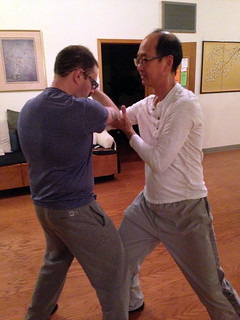The next step in Pushing Hands training is called “Listening Jìn” (聽勁). Instead of listening with your ears, however, you use another skill called “Sticking and Adhering” to keep a part of your body (usually the hands) against the opponent at all times. Then, you can use every part of you in contact with your opponent to feel where his force is going. By listening (feeling), you can predict where he is going and what his intent is. Of course, in a fight this is essential, since you cannot defend against something you don’t know is coming. By listening, you always know what’s coming.
I find it incredibly insightful that the Chinese call this technique “Listening.” It’s an important skill to develop. During my Pushing Hands learning process, I quickly discovered that in order to feel where an opponent was pushing, I had to quiet my mind and pay total attention to what I was doing. If my mind wandered, I would miss sensing an incoming force, and my training partner could easily push me. In the beginning, I fell over a lot. From the perspective of an emotional conflict, Listening is an equally important skill, and it requires that you quiet your mind and pay attention.
Neutralization is the next skill in the list. Early on in Pushing Hands, I learned that by moving my hips as a force came at me, I could turn that force, moving it in a direction that was harmless to me. In many ways, it’s similar to rooting, but instead of directing the force into the ground, you train yourself to direct the force in some other direction. From a psychological standpoint, we have to be able to deflect the hurtful things that other people say. The fact is that often when people are mad, they say things they don’t mean. We can choose to take it personally, or we can chalk it up to that person’s temper. If we take it personally, a disagreement will rapidly degenerate, turning into a fight in which people just trade insults.
 Redirecting builds upon the skill of Neutralization. It is the ability to choose in which direction you neutralize someone’s force. In Pushing Hands, the object is to redirect someone’s own force in a direction that will help unbalance them. In an argument, Redirecting is the way we keep the encounter moving in a positive direction.
Redirecting builds upon the skill of Neutralization. It is the ability to choose in which direction you neutralize someone’s force. In Pushing Hands, the object is to redirect someone’s own force in a direction that will help unbalance them. In an argument, Redirecting is the way we keep the encounter moving in a positive direction.
Now that we’ve examined those skills, let’s take a hypothetical situation and see how they can be applied. Let’s say that someone at your work comes to you and says, “I’m mad at you because you did this or that thing that I didn’t want you to do.” You immediately use mental Rooting by reminding yourself that they are the angry one. You don’t have to be angry just because they are. Their anger is not necessarily a personal attack, and this is their problem, not yours. The next step is to Listen. Sometimes people aren’t mad for the reasons they say they are. Sometimes when something else is going on, we become so hypersensitive that every little thing sets us off. The only way to discover the truth behind how someone is feeling is to Listen. After that, you Neutralize and Redirect by responding, “It wasn’t my intention to make you mad. I’m sorry. Is there a way we can fix this?”
Nine times out of every ten, this will lead to a happy resolution for the problem. However, sometimes people feel that they need to be angry. Often times, they will continue to lash out even after you have Rooted, Listened, Neutralized, and Redirected. In those cases, it’s best to get out of the situation until the other person has calmed down enough to talk.
When faced with irrational anger, I have occasionally resorted to saying, “How long do you need to be mad? I can come back later and we can try to fix this.” Often that snaps the other person out of it long enough to get something positive done about the situation. In other cases, I’ve left, and later been approached by the person when they were more interested in working out our differences. The important thing is that I left suggesting that the next time we were together we could try to make it right.
Interestingly enough, I have found that the more I practice Pushing Hands, the more often those techniques are reinforced, and the less often I have fights—verbal or otherwise. Truth be told, it’s not something limited to my own personal experience. I’ve seen it with my martial arts brothers and sisters as well as with my students. I find that regular Pushing Hands training makes my colleagues, my students, and me calmer, happier, and less negatively affected by conflict.

Leave a Reply